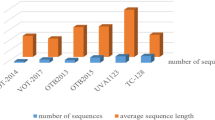Abstract
Interest point detection is a challenging problem in 3D objects. Compared to traditional corner detection based on the curvature, this paper proposes a novel method that quantifies the balance and uniformity of local geometric structures based on the distribution of vertex neighborhoods. We first define the neighborhoods of vertices and structure them within the two-ring, instead of constructing the overall mesh, so as to avoid the interference between the neighborhoods of different vertices. Then we introduce the concept "balance-distortion" to describe the geometric features of the local structure. The experimental results show that the proposed algorithm is robust against noise and invariant to geometric transformation. In addition, compared with the corner detection, more feature points that do not satisfy the balance and direction uniformity are detected, and the distribution of interest point is more uniform.













Similar content being viewed by others
References
Azimi, S., Lall, B., Gandhi, T.K.: Performance evalution of 3D keypoint detectors and descriptors for plants health classification (2019)
Novatnack, J., Nishino, K.: Scale-dependent 3D geometric features. In: IEEE 11th International Conference on Computer Vision, ICCV 2007, Rio de Janeiro, Brazil, 14–20 Oct 2007, pp. 1–8 (2007)
Sipiran, I., Bustos, B.: Harris 3D: a robust extension of the Harris operator for interest point detection on 3D meshes. Vis. Comput. 27(11), 963–976 (2011)
Ho, H., Gibbins, D.: Curvature-based approach for multi-scale feature extraction from 3D meshes and unstructured point clouds. IET Comput. Vis. 3(4), 201 (2009)
Steder, B., Rusu, R. B., Konolige, K., Burgard, W.: Narf: 3d range image features for object recognition. In: Workshop on Defining and Solving Realistic Perception Problems in Personal Robotics at the IEEE/RSJ International Conference on Intelligent Robots and Systems (2010). https://www.researchgate.net/publication/260320178_NARF_3D_Range_Iage_Features_for_Object_Recognition
Lee, C.H., Varshney, A., Jacobs, D.W.: Mesh saliency. ACM Trans. Graph. 24, 659–666 (2005)
Tombari, F., Salti, S., Distefano, L.: Performance evaluation of 3D keypoint detectors. Int. J. Comput. Vis. 102(1), 198–220 (2013)
Zaharescu, A., Boyer, E., Horaud, R.: Keypoints and local descriptors of scalar functions on 2D manifolds. Int. J. Comput. Vis, 100(1), 78–98 (2012)
Feng, K., Li, Q., Gong, Y., et al.: Detection of imbalanced vertices in 3D meshes. In: International Conference on Digital Home. IEEE Computer Society (2016)
Gelfand, N., Mitra, N.J., Guibas, L.J, et al.: Robust global registration. In: Proceedings of the Third Eurographics Symposium on Geometry Processing. Eurographics Association (2005)
Sun, J., Ovsjanikov, M., Guibas, L.: A concise and provably informative multi-scale signature based on heat diffusion. Comput. Graph. Forum 28(5), 1383–1392 (2009)
Niu, D., Guo, H., Zhao, X., et al.: Three-dimensional salient point detection based on the Laplace–Beltrami eigenfunctions. Vis. Comput. 36(4), 767–784 (2019)
Tombari, F., Salti, S., Distefano, L.: Performance evaluation of 3D keypoint detectors. In: International Conference on 3d Imaging, pp. 198–220. Springer US (2013)
Zhao, H., Yang, D., et al.: 3D target detection using dual domain attention and SIFT operator in indoor scenes. Vis. Comput. (2021). https://doi.org/10.1007/s00371-021-02217-z
Zou, G., Hua, J., Lai, Z., et al.: Intrinsic geometric scale space by shape diffusion. IEEE Trans. Visual Comput. Graph. 15(6), 1193–1200 (2009)
Gu, X., Wang, S., Kim, J., Zeng, Y., Wang, Y., Qin, H., Samaras, D.: Ricci flow for 3D shape analysis. In: Proceedings of ICCV 07, pp. 1–8 (2007).
Rusu, R.B., Blodow, N., Beetz, M.: Fast point feature histograms (FPFH) for 3D registration. In: IEEE International Conference on Robotics & Automation. IEEE (2009)
Castellani, U., Cristani, M., Fantoni, S., et al.: Sparse Points Matching by Combining 3D Mesh Saliency with Statistical Descriptors, pp. 643–652. Wiley, Hoboken (2010)
Ding, X., Lin, W., Chen, Z., et al.: Point cloud saliency detection by local and global feature fusion. IEEE Trans. Image Process. 28(11), 5379–5393 (2019)
Guo, Y., et al.: Point-wise saliency detection on 3D point clouds via covariance descriptors. Vis. Comput. 34, 1325–1338 (2018). https://doi.org/10.1007/s00371-017-1416-3
Novatnack, N.: Scale-dependent 3D geometric features. In: IEEE International Conference on Computer Vision. IEEE (2007)
Teran, L,, Mordohai, P.: 3D interest point detection via discriminative learning. In: European Conference on Computer Vision. Springer International Publishing (2014)
Tonioni, A., Salti, S., Tombari, F., et al.: Learning to detect good 3D keypoints. Int. J. Comput. Vis. 126(3), 1–20 (2018)
3D interest point detection via discriminative learning. In: European Conference on Computer Vision, pp. 159–173 (2014)
Hoppe, H.: Surface reconstruction from unorganized points (Ph.D. thesis). ACM SIGGRAPH Comput. Graph. 26(2), 71–78 (1992)
Dutagaci, H., Cheung, C.P., Godil, A.: Evaluation of 3D interest point detection techniques via human-generated ground truth. Vis. Comput. 28(9), 901–917 (2012)
Salti, S., Tombari, F., Stefano, L.D.: A performance evaluation of 3D keypoint detectors. In: International Conference on 3D Imaging. IEEE Computer Society (2011)
Bronstein, A., Bronstein, M., Bustos, B., Castellani, U., Crisani, M., Falcidieno, B., Guibas, L.J., Kokkinos, I., Murino, V., Sipiran, I., Ovsjanikov, M., Patane, G., Spagnuolo, M., Sun, J.: SHREC 2010: robust feature detection and description benchmark. In: Proceeding on Eurographics Workshop on 3D Object Retrieval, pp. 79–86. Eurographics Association, Aire-la-Ville (2010)
Acknowledgements
This work was supported by the Strategic Priority Research Program of the Chinese Academy of Sciences (Grant No. XDC04000000), the National Natural Science Foundation of China (Grant No. 62073312), the Key Research and Development Program of LiaoNing (Grant No. 2020JH2/10100023), China Aero-engine Independent Innovation Special Fund Project (Grant No. ZZCX-2018-035), LiaoNing Revitalization Talents Program and K.C. Wong Education Foundation.
Author information
Authors and Affiliations
Corresponding author
Ethics declarations
Conflict of interest
The authors declare that they have no conflict of interest.
Additional information
Publisher's Note
Springer Nature remains neutral with regard to jurisdictional claims in published maps and institutional affiliations.
Rights and permissions
About this article
Cite this article
Jiang, Y., Li, X., Liu, Y. et al. 3D interest point detection using balance-distortion oriented selection. Vis Comput 39, 733–747 (2023). https://doi.org/10.1007/s00371-021-02371-4
Accepted:
Published:
Issue Date:
DOI: https://doi.org/10.1007/s00371-021-02371-4




